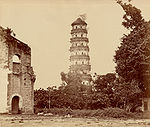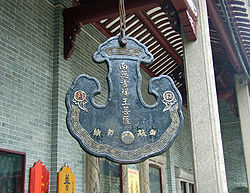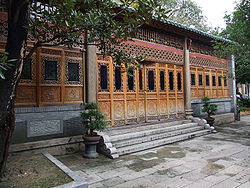
Temple of the Six Banyan Trees
Encyclopedia



Buddhism
Buddhism is a religion and philosophy encompassing a variety of traditions, beliefs and practices, largely based on teachings attributed to Siddhartha Gautama, commonly known as the Buddha . The Buddha lived and taught in the northeastern Indian subcontinent some time between the 6th and 4th...
temple originally built in 537 in the Liang Dynasty
Liang Dynasty
The Liang Dynasty , also known as the Southern Liang Dynasty , was the third of the Southern dynasties in China and was followed by the Chen Dynasty...
in Guangzhou
Guangzhou
Guangzhou , known historically as Canton or Kwangchow, is the capital and largest city of the Guangdong province in the People's Republic of China. Located in southern China on the Pearl River, about north-northwest of Hong Kong, Guangzhou is a key national transportation hub and trading port...
, southern China
China
Chinese civilization may refer to:* China for more general discussion of the country.* Chinese culture* Greater China, the transnational community of ethnic Chinese.* History of China* Sinosphere, the area historically affected by Chinese culture...
.
The temple's proximity to foreign consulates in Guangzhou has made it a regular destination for families participating in the international adoption
International adoption
International adoption is a type of adoption in which an individual or couple becomes the legal and permanent parents of a child that is a national of a different country...
of children from China. Typically families receive blessings for their newly adopted children at this temple in front of the statue of Kuan Yin
Kuan Yin
Guanyin is the bodhisattva associated with compassion as venerated by East Asian Buddhists, usually as a female. The name Guanyin is short for Guanshiyin which means "Observing the Sounds of the World". She is also sometimes referred to as Guanyin Pusa...
.
History
The Temple of the Six Banyan Trees was originally called the Baozhuangyan Temple, but during the Northern Song Dynasty, a writer called Su ShiSu Shi
Su Shi , was a writer, poet, artist, calligrapher, pharmacologist, gastronome, and statesman of the Song Dynasty, and one of the major poets of the Song era. His courtesy name was Zizhan and his pseudonym was Dongpo Jushi , and he is often referred to as Su Dongpo...
wrote the inscription Liu Rong (Six Banyan Trees) because of the six banyan tree
Banyan
A banyan is a fig that starts its life as an epiphyte when its seeds germinate in the cracks and crevices on a host tree...
s he saw there and it has since been called the Temple of the Six Banyan Trees.
The temple was burned down and rebuilt in the Northern Song Dynasty. Flower Pagoda, the main structure of the temple, was built in 1097, and was named for its colorful exterior. The Flower Pagoda once had a square base in its architecture, but was given an octagonal shaped base after it was rebuilt in 1097. It was rebuilt again in 1373 AD after another fire in the early Ming Dynasty
Ming Dynasty
The Ming Dynasty, also Empire of the Great Ming, was the ruling dynasty of China from 1368 to 1644, following the collapse of the Mongol-led Yuan Dynasty. The Ming, "one of the greatest eras of orderly government and social stability in human history", was the last dynasty in China ruled by ethnic...
period, and restored in 1900.
External links
- Temple of the Six Banyan Trees at travelchinaguide.com
- http://www.nudieman.com/anrg/flower_pagoda.htm (Description and some pictures)

